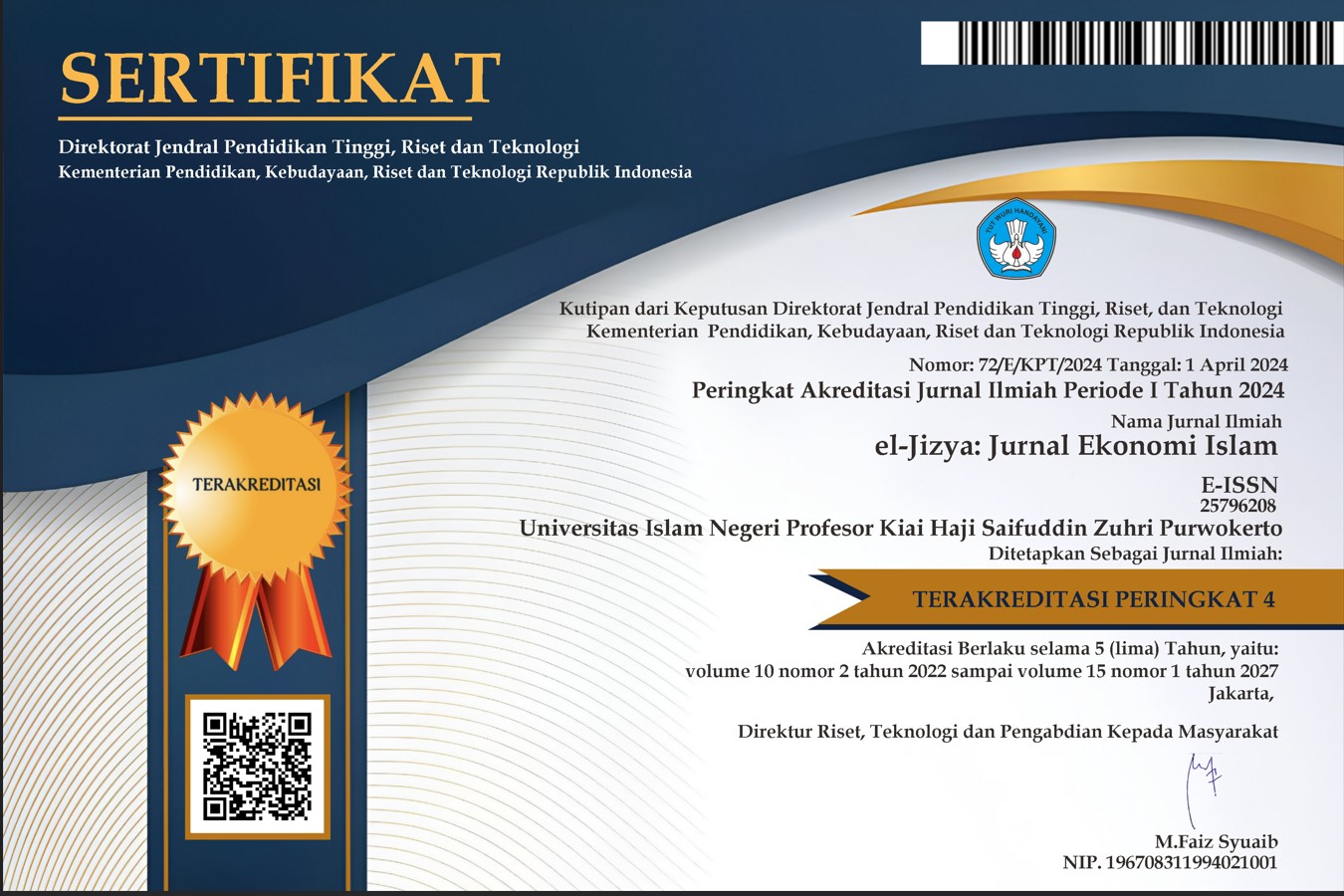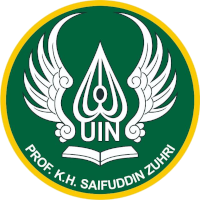The Influence of Islamic Capital Market Capitalization and Labor Force on the Economic Growth of Indonesia
DOI:
https://doi.org/10.24090/ej.v12i2.10381Keywords:
sukuk, Economic growth, Islamic finance, Total Deposit, Total Financing, Economic Development, Investment, ZIS, Human Development Index, Labor, Economic GrowthAbstract
Sharia capital and labor markets play an important role in driving the economy of a country, including Indonesia. Sharia capital market capitalization is a key indicator of organized economic activity and has a significant impact on the allocation of resources to economic sectors with potential for growth. On the other hand, labor is the main asset in realizing economic potential through their productivity and contribution to development. This study examines the impact of Islamic Capital Market Capitalization and Labor on Indonesia's Economic Growth. It utilizes secondary data in the form of time series data from the Central Bureau of Statistics and the Financial Services Authority for the period 2014-2022. The analysis method employed is quantitative analysis, and the Error Correction Model (ECM) is used for the analysis. The study findings indicate that:(a) The sukuk variable has a positive and significant effect on Indonesia's economic growth. (b) The Sharia mutual fund variable also has a positive and significant effect on Indonesia's economic growth. (c) The labor variable positively and significantly influences Indonesia's economic growth.References
Ala’uddin, M. (2020). Bank Syariah, Saham Syariah, Obligasi Syariah dan Inflasi Terhadap Pertumbuhan Ekonomi. Qiema, 6(2), 234–254. http://ejournal.kopertais4.or.id/pantura/index.php/qiema/article/view/3526
Alvionita, M. (2021). Pengaruh Penerbitan Obligasi dan Sukuk Terhadap Pertumbuhan Ekonomi Indonesia. Jurnal Ilmiah, 8(1).
Arini, P. R., & Kusuma, M. W. (2019). Pengaruh Belanja Modal Dan Pendapatan Asli Daerah Terhadap Investasi Swasta Di Indonesia Dengan Pertumbuhan Ekonomi Sebagai Variabel Intervening. Jurnal Riset Akuntansi Mercu Buana, 5(1), 28. https://doi.org/10.26486/jramb.v5i1.611
Auliyatusaa’dah, N., Handayani, D. I., & Farekha. (2021). Pengaruh saham dan reksanadana syariah terhadap pertumbuhan ekonomi Indonesia 2013-2019. JIEF: Journal of Islamic Economics and Finance, 1(1), 37–45.
Awaluddin. (2016). Pasar Modal Syariah : Analisis Penawaran Efek Syariah Di Bursa Efek Indonesia. Maqdis : Jurnal Kajian Ekonomi Islam, 1(2), 137–150. http://journal.febi.uinib.ac.id/index.php/maqdis/article/view/42
Bawuno, E. E., Kalangi, J. B., & Sumual, J. I. (2015). Pengaruh Investasi Pemerintah dan Tenaga Kerja Terhadap Pertumbuhan Ekonomi Di Kota Manado (Studi Pada Kota Manado Tahun 2003-2012). Jurnal Berkala Ilmiah Efisiensi, 15(04), 245–254. https://ejournal.unsrat.ac.id/index.php/jbie/article/view/9498
BPS. (2022). Konsep/penjelasan teknis tenaga kerja. Badan Pusat Statisik. https://www.bps.go.id/subject/6/tenaga-kerja.html#subjekViewTab1
BPS. (2023). Produk Domestik Bruto. Badan Pusat Statistik. https://www.bps.go.id/subject/11/produk-domestik-bruto--lapangan-usaha-.html#:~:text=PDB adalah jumlah nilai tambah,tertentu (biasanya satu tahun).
Buana, A. L., Saragih, H. J. R., & Aritonang, S. (2018). Pengaruh Pengeluaran Pemerintah, Investasi Pemerintah,Investasi Swasta Dan Tenaga Kerja Terhadap Pertumbuhan Ekonomi Di Pulau Jawa Tahun 2011-2015. Jurnal Ekonomi Pertahanan, 4(2), 1–20.
Faiza, N. A. R., & Shafiyatun. (2018). Pengaruh Nilai Outstanding Sukuk Korporasi Terhadap Produk Domestik Bruto (Pdb) Indonesia (Periode Triwulanan Tahun 2011-2017). Jurnal El-Qist, 08(01), 1577–1596.
Fajar, F., Rizali, R., & Rahmini, N. (2022). Kontribusi Saham Syariah, Sukuk, Reksadana Syariah dan Saham Konvensional Terhadap Pertumbuhan Ekonomi Nasional. Syntax Idea, 4(1), 77. https://doi.org/10.36418/syntax-idea.v4i1.1750
Irawan, A. (2018). Pasar modal syariah. Elex Media Komputindo.
Irawan, & Siregar, Z. (2019). Pengaruh Saham Syariah, Sukuk dan Reksadana Syariah Terhadap Pertumbuhan Ekonomi Indonesia. Tansiq, 2(1), 989–1011. https://doi.org/10.1016/j.addr.2018.07.012%0Ahttp://www.capsulae.com/media/Microencapsulation - Capsulae.pdf%0Ahttps://doi.org/10.1016/j.jaerosci.2019.05.001
Kadir, Rahim, M., & Ode, S. a. (2016). Pengaruh Investasi dan Konsumsi Terhadap Penyerapan Tenaga Kerja Pada Sektor Industri Pengolahan di Kota Kendari. Jurnal Ekonomi, 1(1), h. 14.
Masruroh, A. (2014). Konsep Dasar Investasi Reksadana. SALAM: Jurnal Sosial Dan Budaya Syar-I, 1(1). https://doi.org/10.15408/sjsbs.v1i1.1526
Mukamad Rofii, A., & Sarda Ardyan, P. (2017). Analisis Pengaruh Inflasi, Penanaman Modal Asing (Pma) Dan Tenaga Kerja Terhadap Pertumbuhan Ekonomi Di Jawa Timur. JEB 17 Jurnal Ekonomi & Bisnis, 2(1), 303–316.
Mulyadi, S. (2014). Ekonomi Sumber Daya Manusia Dalam Perspektif Pembangunan. PT. Raja Grafindo Persada.
Murtala, & Iskandar, I. (2017). Analisis Tenaga Kerja Dan Pertumbuhan Ekonomi Di Indonesia Dengan Menggunakan Metode Vector Autoregressive. Jurnal Ekonomi Dan Pembangunan, 8(1), 66–73. https://doi.org/10.22373/jep.v8i1.69
Nida, D. R. P. P., Yoga, I. G. A. P., & Adityawarman, I. M. G. (2020). Analisis Reaksi Pasar Modal Terhadap Peristiwa Pemilu Serentak Tahun 2019. Wicaksana: Jurnal Lingkungan Dan Pembangunan, 4(1), 64–73. https://doi.org/10.22225/wicaksana.4.1.1813.64-73
Nurafiati, N. (2019). Perkembangan Pasar Modal Syariah Dan Kontribusinya Terhadap Pertumbuhan Ekonomi Di Indonesia. Inklusif (Jurnal Pengkajian Penelitian Ekonomi Dan Hukum Islam), 4(1), 65. https://doi.org/10.24235/inklusif.v4i1.4167
Nurhidayah, D., Hidayati, A. N., & Habib, M. A. F. (2022). Pengaruh Inflasi , Saham Syariah , Sukuk dan Reksadana Syariah terhadap Pertumbuhan Ekonomi Nasional Tahun 2013-2020 The Influence of Inflation , Sharia Stock , Sukuk and Sharia Mutual Funds on National. Jurnal Sinar Manajemen, 09, 158–173.
Nurmawilis, tia okta, Cantika, vebio syaf, & Mayusfa, Y. (2021). Peran Pasar Modal Syariah Dalam Laju Pertumbuhan Ekonomi Di Indonesia. Jurnal Pendidikan Tambusai, 5(3), 10916–10923. https://doi.org/10.15575/km.v2i1.11635
OJK. (2023). Sejarah Pasar Modal Syariah. Otoritas Jasa Keuangan. https://www.ojk.go.id/id/kanal/pasar-modal/pages/syariah.aspx#:~:text=Sejarah Pasar Modal Syariah di,Index pada tanggal 3 Juli
Pratama, A. G. K., & Darsana, ida B. (2019). Pengaruh Kemiskinan Dan Investasi Terhadap Pertumbuhan Ekonomi Dan Kesejahteraan Masyarakat. E-Jurnal EP Unud, 8 [6]: 1300-1330, 8(6), 1300–1330.
Purnamawati, I. (2015). Perbandingan Sukuk Dan Obligasi (Telaah Dari Perspektif Keuangan Dan Akuntansi). Jurnal Akuntansi Universitas Jember, 11(1), 62. https://doi.org/10.19184/jauj.v11i1.1261
Putriana. (2017). 10-2016Reksadana Syariah VS Reksadana Konvensional: Analisis Pertumbuhan dan Perkembangan Tahun 2010-2016. Jurnal Al-Iqtishad, II, 40–42.
Sukirno, S. (2011). Makro Ekonomi Teori Pengantar (1st ed.). rajagrafindo persada.
Sumarni, M., & Suprihanto, J. (2014). Pengantar Bisnis Dasar-Dasar Ekonomi Perusahaan. Liberty.
Todaro, Michael P. (2003). Pembangunan Ekonomi di Dunia Ketiga (kedelapan). Erlangga.
Todaro, Michael P, & Smith, S. C. (2006). Pembangunan Ekonomi Jilid 1 (H. Munandar (trans.); Kesembilan). Erlangga.
Todaro, Micheael P. (2000). Pembangunan Ekonomi. Edisi kelima. Penerbit Erlangga.
Wirman. (2020). Pengaruh Nilai Tukar (Kurs), Jumlah Uang Beredar Dan Inflasi Terhadap Nilai Aktiva Bersih Reksa Dana Syariah Di Indonesia Tahun 2015-2019. ACCOUNTHINK : Journal of Accounting and Finance, 5(02), 239–258. https://journal.unsika.ac.id/index.php/accounthink/article/view/4311
Yunita, M., & Sentosa, S. U. (2019). Pengaruh Pajak, Penanaman Modal Dalam Negeri (Pmdn) Dan Tenaga Kerja Terhadap Pertumbuhan Ekonomi Di Indonesia. Jurnal Kajian Ekonomi Dan Pembangunan, 1(2), 533. https://doi.org/10.24036/jkep.v1i2.6265
Yusuf, M., Ichsan, R. N., & Saparuddin. (2021). Determinasi Investasi Dan Pasar Modal Syariah. Jurnal Kajian EKonomi Dan Kebijakan Publik, 6(1), 397–401. http://jurnal.pancabudi.ac.id/index.php/jepa/article/view/1121/1001
Downloads
Published
How to Cite
Issue
Section
License
Copyright (c) 2024 Deky Candra Saputra; Muhammad Ikhsan

This work is licensed under a Creative Commons Attribution-ShareAlike 4.0 International License.
Authors who publish with this journal agree to the following terms:
- Authors retain copyright and grant the journal right of first publication with the work simultaneously licensed under a Creative Commons Attribution-ShareAlike License that allows others to share the work with an acknowledgement of the work's authorship and initial publication in this journal.
- Authors are able to enter into separate, additional contractual arrangements for the non-exclusive distribution of the journal's published version of the work (e.g., post it to an institutional repository or publish it in a book), with an acknowledgement of its initial publication in this journal.
- Authors are permitted and encouraged to post their work online (e.g., in institutional repositories or on their website) prior to and during the submission process, as it can lead to productive exchanges, as well as earlier and greater citation of published work (See The Effect of Open Access).















